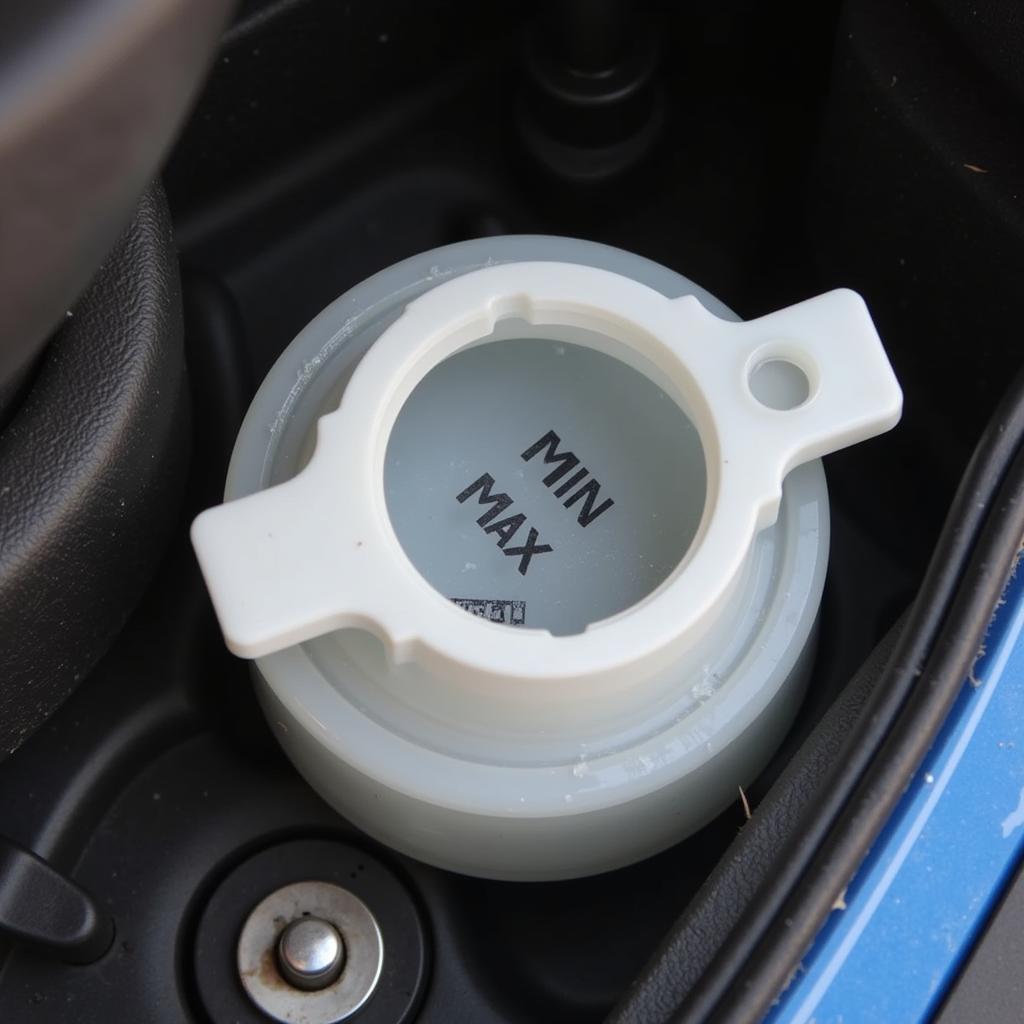The brake fluid warning light on your Hyundai i10 dashboard is a crucial safety indicator. When illuminated, it signals a potential issue with your braking system that needs immediate attention. Ignoring this warning could lead to reduced braking efficiency or even brake failure, putting you and others at risk.
Understanding Your Hyundai i10’s Brake System and Warning Light
Your Hyundai i10’s brake system operates on hydraulic pressure. When you press the brake pedal, it activates a piston in the master cylinder, pushing brake fluid through hydraulic lines to the calipers at each wheel. This pressure forces the brake pads against the rotors, creating friction and slowing down or stopping your car.
The brake fluid warning light is designed to alert you to a drop in brake fluid pressure, which can occur due to:
- Low brake fluid level: This is the most common cause, often indicating a leak in the system.
- Worn brake pads: As brake pads wear down, the brake calipers need more fluid to engage. If the fluid level is low, the warning light might illuminate.
- Faulty brake master cylinder: A malfunctioning master cylinder may not be able to build adequate pressure, triggering the warning light.
- Issues with the brake lines or hoses: Leaks or blockages in the lines carrying brake fluid can lead to pressure loss and activate the warning light.
What to Do When Your Hyundai i10’s Brake Fluid Warning Light Turns On
1. Stop Safely and Immediately: Do not continue driving with an illuminated brake fluid warning light. Pull over to a safe location as soon as possible.
2. Check Your Brake Fluid Level: With the engine off, locate the brake fluid reservoir under the hood. It’s typically a translucent plastic container with a black cap. Caution: Brake fluid is corrosive. Avoid contact with skin or paint.
3. Top Up If Necessary: If the fluid level is below the “MIN” mark, carefully add the correct DOT specification brake fluid recommended in your owner’s manual.
4. Inspect for Leaks: Visually examine the area around the master cylinder, brake lines, and near the wheels for any signs of fluid leakage.
 Hyundai i10 Brake Fluid Reservoir
Hyundai i10 Brake Fluid Reservoir
5. Seek Professional Help: If you notice a leak, the fluid level is extremely low, or the warning light remains on after adding fluid, do not attempt to drive your car. Contact a qualified mechanic or your Hyundai dealership immediately.
Remote Diagnostics and Software Solutions for Hyundai i10 Brake Issues
In some cases, the brake fluid warning light might be triggered by electronic malfunctions or software glitches within your Hyundai i10’s braking system. Modern cars heavily rely on sensors and electronic control units (ECUs) to manage braking performance and safety features like Anti-lock Braking System (ABS) and Electronic Stability Control (ESC).
As a specialist in automotive electrical engineering, I utilize advanced remote diagnostics and software solutions to identify and rectify such issues. Using specialized equipment, I can connect to your Hyundai i10’s onboard computer system remotely and:
-
Read and interpret fault codes: This helps pinpoint the root cause of the warning light, even if it’s an intermittent electrical fault.
-
Analyze sensor data: By monitoring data from various sensors, I can assess the functionality of individual components within the braking system.
-
Perform software updates and calibrations: In some situations, updating your Hyundai i10’s software to the latest version or recalibrating specific systems can resolve software-related issues that trigger the brake fluid warning light.
“I’ve seen instances where a simple software update resolved persistent brake fluid warning light issues in Hyundai i10s,” says John Miller, a certified automotive electrician with over 15 years of experience. “These advanced diagnostics tools allow us to address problems efficiently without unnecessary part replacements.”
Importance of Timely Brake System Inspection and Maintenance
Regular inspection and maintenance of your Hyundai i10’s braking system is crucial for ensuring optimal performance and safety.
-
Brake fluid flush: It’s recommended to flush and replace your brake fluid every 2 years or as specified in your owner’s manual. Brake fluid is hygroscopic, meaning it absorbs moisture over time, which can reduce its effectiveness and lead to corrosion within the system.
-
Brake pad replacement: Worn brake pads are a common cause of braking issues. Have your brake pads inspected regularly and replaced as needed.
-
Inspection of brake lines and hoses: Regularly check your brake lines and hoses for cracks, leaks, or any signs of damage.
“Timely brake maintenance is not just about avoiding costly repairs but more importantly, about preventing potential accidents,” adds Miller. “A well-maintained braking system provides peace of mind knowing you can rely on it when it matters most.”
Conclusion
The brake fluid warning light in your Hyundai i10 should never be ignored. Addressing the underlying issue promptly ensures the optimal performance of your braking system and, most importantly, keeps you safe on the road. Regular maintenance and utilizing professional remote diagnostics can help prevent unexpected issues and keep your Hyundai i10 running smoothly for years to come.
